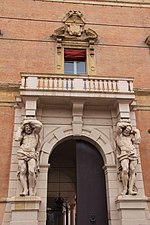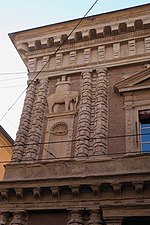Palazzo Hercolani, Bologna
18th-century architecture in ItalyHouses completed in the 18th centuryNeoclassical architecture in BolognaPalaces in Bologna

The Palazzo Hercolani or Ercolani is a large Rococo or Neoclassic-style palace in Strada Maggiore in central Bologna, which now serves as the offices for the Political Science Department (Facoltà di Scienze Politiche) of the University of Bologna.
Excerpt from the Wikipedia article Palazzo Hercolani, Bologna (License: CC BY-SA 3.0, Authors, Images).Palazzo Hercolani, Bologna
Strada Maggiore, Bologna Galvani
Geographical coordinates (GPS) Address Nearby Places Show on map
Geographical coordinates (GPS)
| Latitude | Longitude |
|---|---|
| N 44.491276111111 ° | E 11.353963055556 ° |
Address
Plesso Hercolani - UniBo
Strada Maggiore
40125 Bologna, Galvani
Emilia-Romagna, Italy
Open on Google Maps








